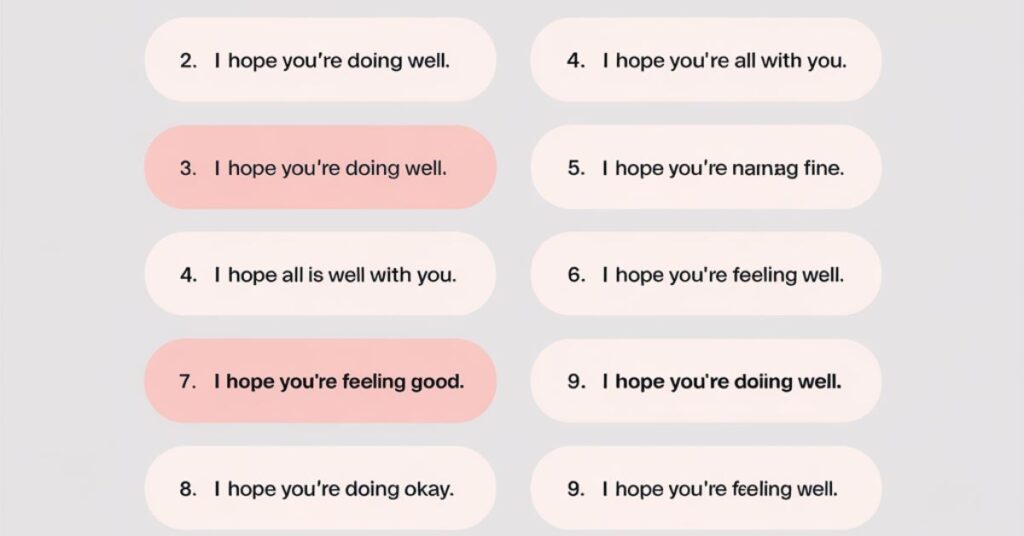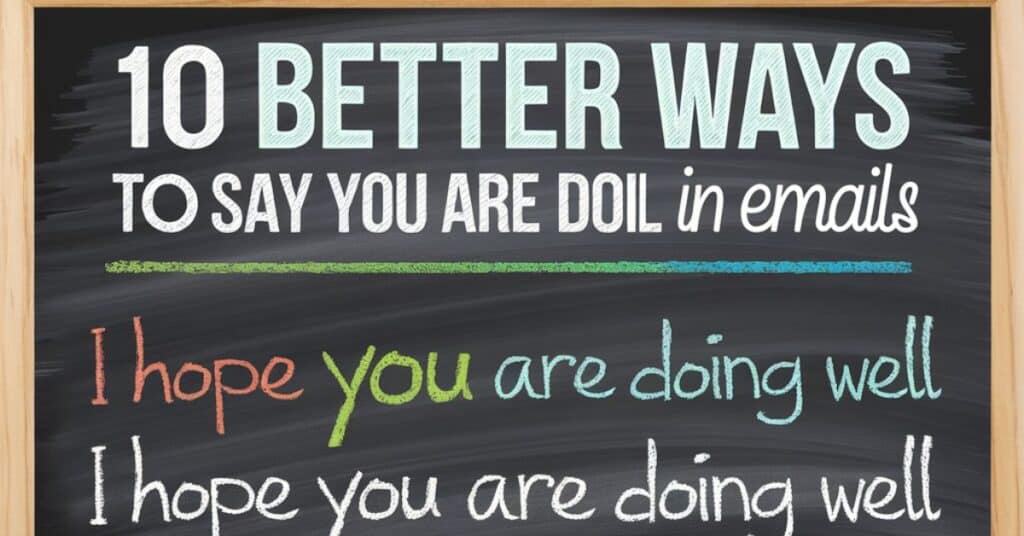If you’re anything like me, you’ve probably found yourself typing “I hope you are doing well” in countless emails or messages. It’s polite, sure, but it can start to feel a bit robotic when you use it over and over again.
That’s why I started looking for alternative ways to express the same sentiment—without sounding like a broken record. Here are 10 options I’ve found helpful, along with examples to help you switch things up.

1. “I trust you’re doing great.”
This one is positive and direct. Instead of hoping someone is well, it assumes they are. I find it’s a good way to inject a little extra confidence into my messages.
Example:
“Hey Sarah, I trust you’re doing great. I wanted to check in on the project status.”
Why I like it: It feels upbeat and sets a positive tone for the rest of the message.
2. “I hope this message finds you in good spirits.”
This phrase feels a bit warmer, in my opinion. I like to use it when I want to go beyond just physical well-being and connect on an emotional level.
Example:
“Good morning, Andrew. I hope this message finds you in good spirits. I was hoping to discuss the upcoming event.”
Why I like it: It’s thoughtful and adds a little extra care to the greeting.
3. “I hope you’re having a productive day.”
For professional settings, this greeting hits the mark. It’s polite, but it also acknowledges the busy nature of someone’s day.
Example:
“Hi Mark, I hope you’re having a productive day. I wanted to follow up on our previous discussion.”
Why I like it: It’s perfect for emails to colleagues or clients when you want to encourage productivity.
4. “I hope all is going smoothly with you.”
I use this when I know someone is juggling a lot or dealing with a busy time. It’s empathetic without being too intrusive.
Example:
“Hi Julie, I hope all is going smoothly with you. Just wanted to see how you’re managing with the new project.”
Why I like it: It shows you care about the challenges they may be facing without prying.
5. “I trust you’re doing well and staying safe.”
This has been a go-to of mine, especially in the past few years. It adds an element of concern for the recipient’s safety and overall well-being.
Example:
“Dear Michael, I trust you’re doing well and staying safe. I wanted to touch base about the meeting next week.”
Why I like it: It’s especially useful in times of uncertainty, showing you’re thinking about their safety.
6. “I hope life is treating you kindly.”
This one’s a little softer and works well when I want to make my message feel more personal.
Example:
“Hi Emma, I hope life is treating you kindly. It’s been a while since we last caught up!”
Why I like it: It’s a gentle and caring way to open a message, perfect for personal notes or casual professional emails.
7. “I trust you’re enjoying a bit of downtime.”
I love this one for when I know someone has been working hard. It’s a nice way to recognize their efforts and hope they’re getting some rest.
Example:
“Hey Tom, I trust you’re enjoying a bit of downtime after that hectic week. Just wanted to ask a quick question.”
Why I like it: It acknowledges their hard work and shows you’re considerate of their need for a break.
8. “I hope everything’s going well on your end.”
This is a versatile option that I use in both personal and professional contexts. It’s neutral, so it fits any situation.
Example:
“Hello Jessica, I hope everything’s going well on your end. Could you update me on the latest developments?”
Why I like it: It’s simple, to the point, and works in almost any conversation.
Also Read This Article: Creative Messages to Say ‘‘Hope You Are Feeling Better
9. “I hope things are going well with you.”
Sometimes, the simplest changes can make a big difference. This one is very similar to the original but fresh enough to keep your message from sounding repetitive.
Example:
“Dear Karen, I hope things are going well with you. I’m writing to discuss our next steps.”
Why I like it: It’s polite and familiar without sounding like a template.
10. “I trust all is well in your world.”
This phrase is a bit more personal and assumes that things are going smoothly. I like using it when I want to show a deeper connection with the recipient.
Example:
“Hi David, I trust all is well in your world. I wanted to ask if you’re available for a quick call.”
Why I like it: It feels genuine and thoughtful, and it’s a nice way to open more personal communications.
Frequently Asked Questions
Why should I stop using “I hope you are doing well” in my emails?
While there’s nothing wrong with using “I hope you are doing well,” it can feel overused and impersonal, especially in frequent communication. Changing up your greeting adds variety and can make your message stand out as more thoughtful or engaging.
Are these alternatives appropriate for professional emails?
Yes! Many of the alternatives suggested, like “I hope you’re having a productive day” or “I trust you are doing great,” work well in professional contexts. Just be mindful of the tone you want to set and choose phrases that match the level of formality needed.
Which alternatives are best for personal messages?
For personal communication, phrases like “I hope life is treating you kindly” or “I trust all is well in your world” add a more intimate, friendly tone. These are great when writing to close friends or family members.
Can these alternatives be used in follow-up emails?
Absolutely! Switching up your greeting in follow-up emails is especially effective. It shows that you’re not just copying and pasting the same message. For follow-ups, try using, “I hope all is going smoothly with you” or “I trust you’re doing well and staying safe.”
How do I choose the right alternative for my message?
Consider the relationship you have with the recipient. For professional emails, it’s best to stick with polite and neutral options, while more personal messages can use warmer, more casual greetings. Also, think about the context—are they busy? Working on a project? That can guide your choice as well.
Final Thoughts
If you’re tired of the same old greetings in your emails and messages, these alternatives can breathe new life into your communication. Whether you’re talking to a colleague, friend, or client, using these variations shows that you’ve put some thought into your message—and that never goes unnoticed.
So next time you find yourself typing “I hope you are doing well,” why not give one of these a try? Trust me, it makes a difference!

“Robert Henry is an experienced blogger with a passion for language and education. His insightful posts on Vocab Scope offer readers valuable tips on vocabulary and grammar. With a background in linguistics and a knack for clear, engaging writing, Robert is dedicated to helping others enhance their communication skills.”






